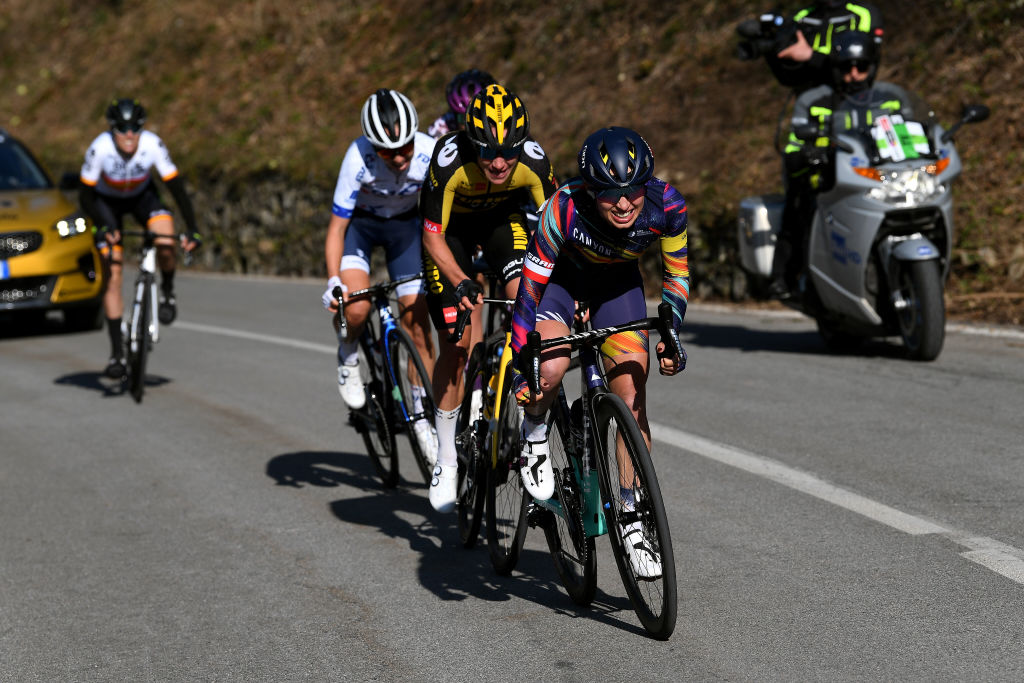Marianne Vos: Longo Borghini was the strongest today
Chase group wary of Jumbo-Visma rider for sprint and unable to close gap to Italian champion

The decisive attack of the Trofeo Alfredo Binda came with 25 kilometres to go, on the climb to Orino. After Trek-Segafredo teammates Ruth Winder and Tayler Wiles had softened up the peloton, Katarzyna Niewiadoma (Canyon-SRAM) made her first move. However, she was caught off guard when Trek’s Elisa Longo Borghini counterattacked and opened a gap.
The Italian champion would not be seen again by the other riders until the finish line, and the high-profile chase group that consisted of Niewiadoma, Marianne Vos (Team Jumbo-Visma), Cecilie Uttrup Ludwig (FDJ Nouvelle-Aquitaine Futuroscope), Soraya Paladin (Liv Racing), and Margarita Victoria García (Alé BTC Ljubljana Cipollini) had to settle for sprinting for second place, a position won by Vos.
“You always want to win, but Longo Borghini was the strongest today,” said the Dutchwoman. “When Elisa attacked, I tried to follow her, but I could not close the gap. After that we chased her with five [riders], full on, but we did not get any closer. Then you know that it will be a fight for the second place.”
Uttrup Ludwig tried to stay with Longo Borghini when the latter attacked, but she too had to let the Italian go. In the end, the Danish climber finished third, replicating her finish from 2019.
“Earlier in the race, I had two mechanicals, so it cost me some energy to return. Luckily, I had Brodie [Chapman] who brought me back,” said Uttrup Ludwig. “When Elisa went on the climb, I lacked that little bit extra to follow her. I am happy with the podium, but I still want more.”
Niewiadoma agreed with Vos and Uttrup Ludwig that they lacked that last bit to be able to follow Longo Borghini, so it is logical that the Italian champion could open a gap.
“I wanted to test my legs and reduce the size of the peloton so it would be easier to find the right position for the last lap,” Niewiadoma said of her attack. “When Elisa attacked, I lacked some acceleration to go with her. I was hoping we could catch her, but we did not manage to do that. I attacked again on the final climb, aiming to open up a gap and go for the podium, but it did not work.”
Once the chase group had come together, the quintet could normally be expected to make up time on a single frontrunner – however, this is where race dynamics and tactics came into play.
In and shortly after the descent from Orino, when the gap was only a few seconds, both Longo Borghini and the chasing group were still at their limit. Later, the presence of Vos, a joint-record as a four-time winner in the Trofeo Binda, who was clearly the strongest sprinter in the group, loomed large: If they worked together to bring back Longo Borghini, wouldn’t Vos just beat them in the sprint?
With this thought in the back of their heads or, like Niewiadoma, already planning a final attack in a bid for a podium spot, some of the riders hesitated to fully commit to the chase.
Longo Borghini, meanwhile, had no such tactics to think about and simply pedalled as fast as she could, eventually winning the race by 1:42 minutes.
“As a team we did a very good race,” Vos said about Jumbo-Visma and securing a podium spot. “We were represented well in the front and had a rider in the break with Anouska [Koster]. That’s why I was able to save myself a little bit longer. As a result, I could save some energy and I could start fresh in the final. That also gives a certain pressure and motivation to do well and reward the team for their work. I am happy that it worked out.”
Get The Leadout Newsletter
The latest race content, interviews, features, reviews and expert buying guides, direct to your inbox!
Lukas Knöfler started working in cycling communications in 2013 and has seen the inside of the scene from many angles. Having worked as press officer for teams and races and written for several online and print publications, he has been Cyclingnews’ Women’s WorldTour correspondent since 2018.